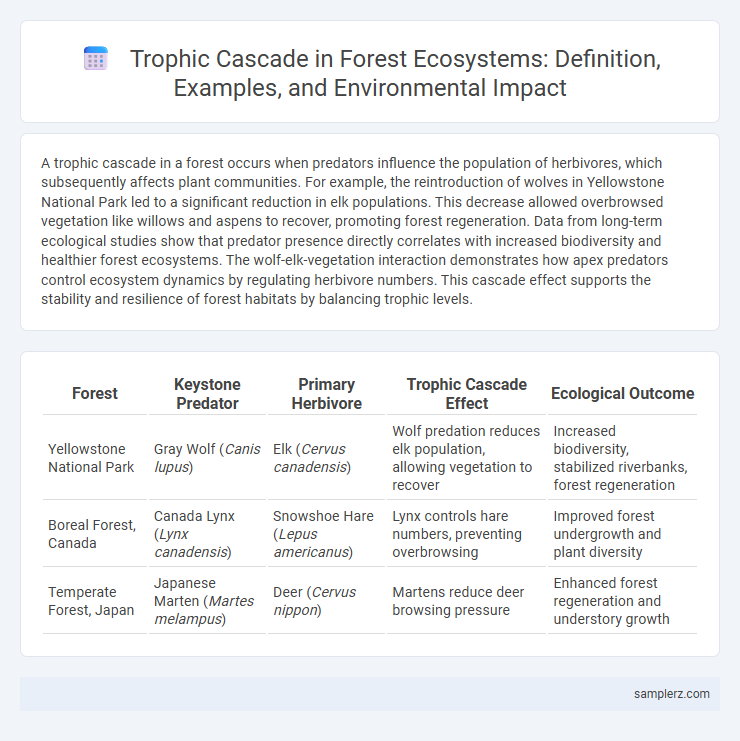A trophic cascade in a forest occurs when predators influence the population of herbivores, which subsequently affects plant communities. For example, the reintroduction of wolves in Yellowstone National Park led to a significant reduction in elk populations. This decrease allowed overbrowsed vegetation like willows and aspens to recover, promoting forest regeneration. Data from long-term ecological studies show that predator presence directly correlates with increased biodiversity and healthier forest ecosystems. The wolf-elk-vegetation interaction demonstrates how apex predators control ecosystem dynamics by regulating herbivore numbers. This cascade effect supports the stability and resilience of forest habitats by balancing trophic levels.
Table of Comparison
| Forest | Keystone Predator | Primary Herbivore | Trophic Cascade Effect | Ecological Outcome |
|---|---|---|---|---|
| Yellowstone National Park | Gray Wolf (Canis lupus) | Elk (Cervus canadensis) | Wolf predation reduces elk population, allowing vegetation to recover | Increased biodiversity, stabilized riverbanks, forest regeneration |
| Boreal Forest, Canada | Canada Lynx (Lynx canadensis) | Snowshoe Hare (Lepus americanus) | Lynx controls hare numbers, preventing overbrowsing | Improved forest undergrowth and plant diversity |
| Temperate Forest, Japan | Japanese Marten (Martes melampus) | Deer (Cervus nippon) | Martens reduce deer browsing pressure | Enhanced forest regeneration and understory growth |
Understanding Trophic Cascades in Forest Ecosystems
Trophic cascades in forest ecosystems occur when changes in predator populations impact multiple trophic levels, exemplified by the reintroduction of wolves in Yellowstone National Park, which controlled elk populations and allowed tree saplings to regenerate. These changes alter vegetation structure, increase biodiversity, and improve ecosystem resilience. Understanding these interactions highlights the importance of apex predators in maintaining forest health and balance.
The Role of Apex Predators in Forest Food Webs
Apex predators like wolves play a crucial role in forest food webs by regulating herbivore populations, which helps maintain vegetation diversity and ecosystem stability. The reintroduction of wolves in Yellowstone National Park led to a trophic cascade that reduced elk overgrazing, allowing tree and shrub regeneration. This cascade demonstrates how apex predators indirectly support biodiversity and forest health through top-down control of the food chain.
Wolves and Elk: Shaping Vegetation Dynamics
Wolves play a critical role in forest ecosystems by controlling elk populations, which prevents overgrazing and allows vegetation to regenerate. The reduction in elk browsing pressure promotes the growth of young trees and shrubs, enhancing biodiversity and stabilizing soil. This trophic cascade demonstrates how apex predators indirectly shape forest structure and function through their influence on herbivore behavior.
Impact of Deer Overpopulation on Forest Understory
Deer overpopulation in forest ecosystems leads to intense browsing pressure on understory vegetation, causing significant declines in plant diversity and density. This trophic cascade disrupts habitat structure, affecting bird species and small mammals dependent on dense understory for shelter and food. Reduced vegetation cover also impacts soil health and nutrient cycling, altering forest regeneration and ecosystem stability.
Predator Reintroduction: Ecosystem Recovery Case Studies
The reintroduction of wolves in Yellowstone National Park exemplifies a trophic cascade in forest ecosystems, where predator presence restored natural balance by controlling elk populations and allowing vegetation regeneration. This top-down regulation triggered increased biodiversity, with the revival of willow and aspen trees supporting diverse bird and beaver habitats. Such predator reintroduction demonstrates critical ecosystem recovery by reestablishing food web dynamics and enhancing forest health.
Effects of Top-Down Control on Forest Biodiversity
Predators such as wolves regulate herbivore populations like deer, preventing overgrazing and allowing diverse plant species to flourish, which enhances forest biodiversity. The reduction in herbivore pressure promotes undergrowth regeneration, creating habitats for various insects and bird species. This top-down control stabilizes ecosystem function by maintaining species richness and trophic complexity in forest environments.
Trophic Cascades and Forest Carbon Storage
Trophic cascades in forests significantly influence carbon storage by regulating herbivore populations, which in turn affect vegetation growth and biomass accumulation. Predators such as wolves control deer populations, preventing overgrazing and promoting forest regeneration, enhancing soil carbon sequestration. This top-down effect ultimately stabilizes carbon pools, supporting climate regulation efforts through sustained forest carbon storage.
Changes in Insect Populations Due to Trophic Shifts
Wolves' reintroduction in Yellowstone National Park triggered a trophic cascade, reducing elk populations and thus allowing vegetation to recover, which altered insect habitats significantly. As plant diversity and density increased, herbivorous insect populations expanded, supporting higher numbers of predatory insects and birds. These shifts in trophic interactions demonstrate how apex predator presence indirectly shapes insect community dynamics and forest ecosystem health.
Human Influence on Forest Trophic Interactions
Human activities such as deforestation and hunting have significantly altered forest trophic cascades by disrupting predator-prey dynamics and reducing biodiversity. The removal of apex predators like wolves leads to overpopulation of herbivores such as deer, causing overgrazing and degradation of vegetation layers in forest ecosystems. These trophic imbalances result in loss of habitat complexity, decreased carbon sequestration capacity, and altered nutrient cycling within affected forests.
Conservation Strategies Leveraging Trophic Cascades
Conservation strategies leveraging trophic cascades in forests focus on restoring apex predators like wolves, which regulate herbivore populations such as deer and elk, thus preventing overgrazing and promoting forest regeneration. This top-down control fosters biodiversity and enhances ecosystem resilience by balancing species interactions and nutrient cycles. Integrating trophic cascade principles into forest management can mitigate habitat degradation and support sustainable conservation outcomes.

example of trophic cascade in forest Infographic
 samplerz.com
samplerz.com